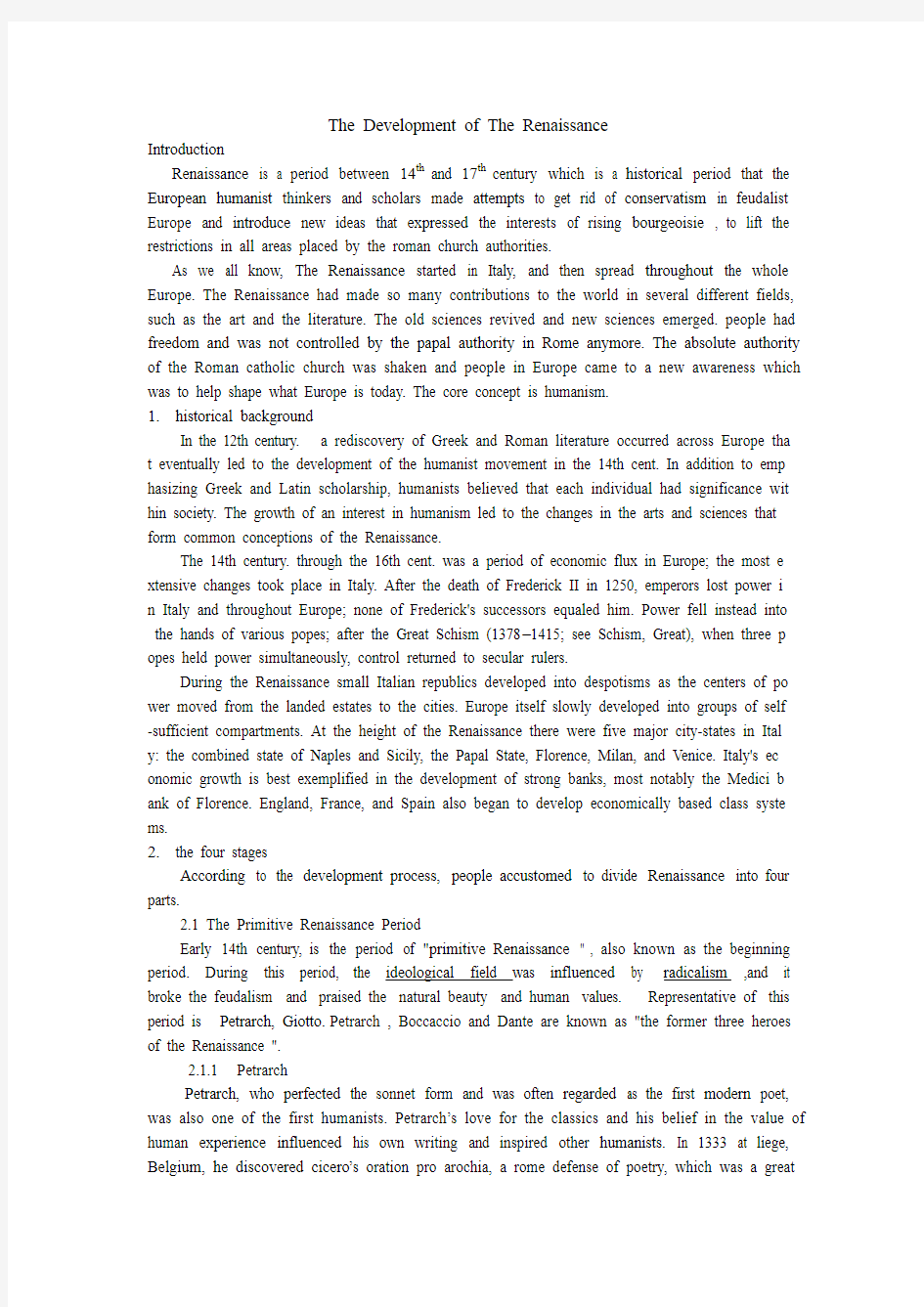
欧洲文化
- 格式:doc
- 大小:37.50 KB
- 文档页数:4


The Development of The Renaissance
Introduction
Renaissance is a period between 14th and 17th century which is a historical period that the European humanist thinkers and scholars made attempts to get rid of conservatism in feudalist Europe and introduce new ideas that expressed the interests of rising bourgeoisie , to lift the restrictions in all areas placed by the roman church authorities.
As we all know, The Renaissance started in Italy, and then spread throughout the whole Europe. The Renaissance had made so many contributions to the world in several different fields, such as the art and the literature. The old sciences revived and new sciences emerged. people had freedom and was not controlled by the papal authority in Rome anymore. The absolute authority of the Roman catholic church was shaken and people in Europe came to a new awareness which was to help shape what Europe is today. The core concept is humanism.
1.historical background
In the 12th century. a rediscovery of Greek and Roman literature occurred across Europe tha t eventually led to the development of the humanist movement in the 14th cent. In addition to emp hasizing Greek and Latin scholarship, humanists believed that each individual had significance wit hin society. The growth of an interest in humanism led to the changes in the arts and sciences that form common conceptions of the Renaissance.
The 14th century. through the 16th cent. was a period of economic flux in Europe; the most e xtensive changes took place in Italy. After the death of Frederick II in 1250, emperors lost power i n Italy and throughout Europe; none of Frederick's successors equaled him. Power fell instead into the hands of various popes; after the Great Schism (1378–1415; see Schism, Great), when three p opes held power simultaneously, control returned to secular rulers.
During the Renaissance small Italian republics developed into despotisms as the centers of po wer moved from the landed estates to the cities. Europe itself slowly developed into groups of self -sufficient compartments. At the height of the Renaissance there were five major city-states in Ital y: the combined state of Naples and Sicily, the Papal State, Florence, Milan, and Venice. Italy's ec onomic growth is best exemplified in the development of strong banks, most notably the Medici b ank of Florence. England, France, and Spain also began to develop economically based class syste ms.
2.the four stages
According to the development process, people accustomed to divide Renaissance into four parts.
2.1 The Primitive Renaissance Period
Early 14th century, is the period of "primitive Renaissance " , also known as the beginning period. During this period, the ideological field was influenced by radicalism ,and it broke the feudalism and praised the natural beauty and human values. Representative of this period is Petrarch, Giotto.Petrarch , Boccaccio and Dante are known as "the former three heroes of the Renaissance ".
2.1.1 Petrarch
Petrarch, who perfected the sonnet form and was often regarded as the first modern poet, was also one of the first humanists. Petrarch’s love for the classics and his belief in the value of human experience influenced his own writing and inspired other humanists. In 1333 at liege, Belgium, he discovered cicero’s oration pro arochia, a rome defense of poetry, which was a great